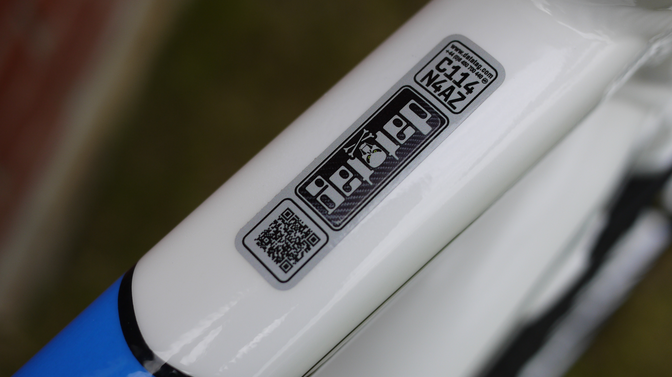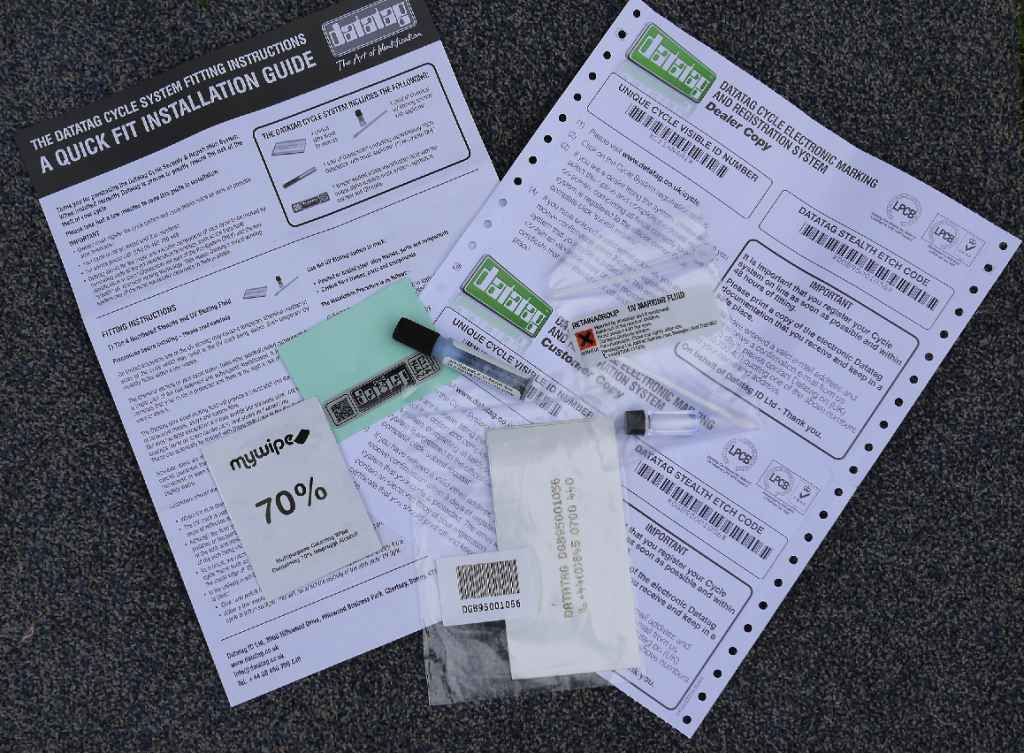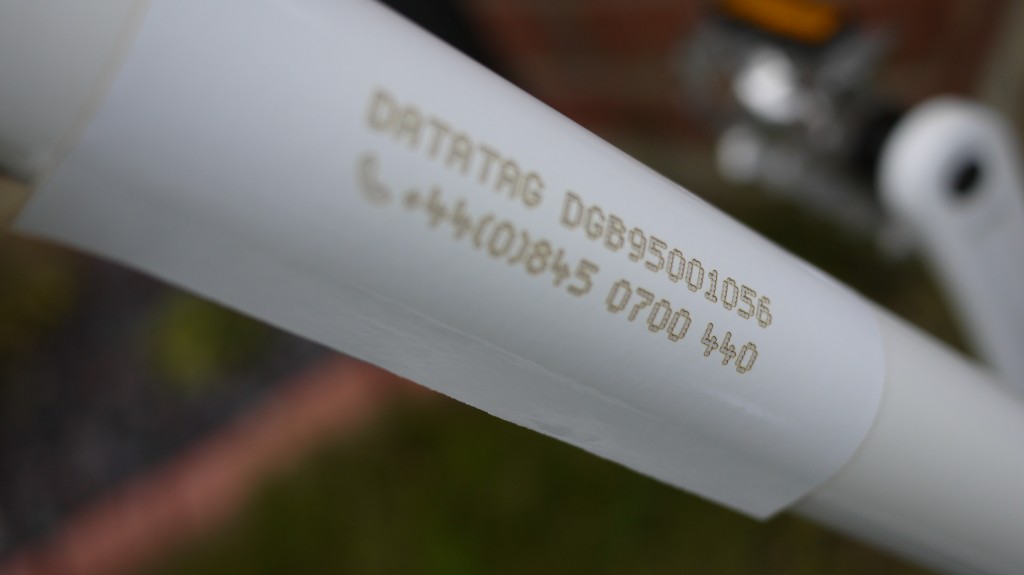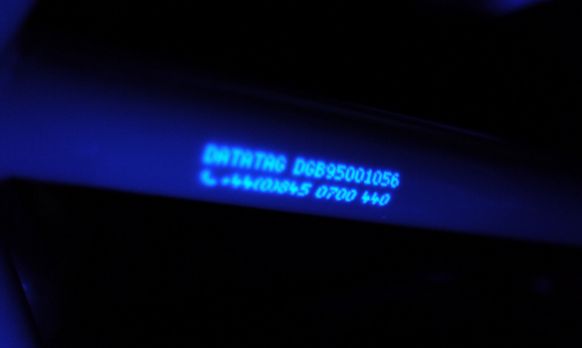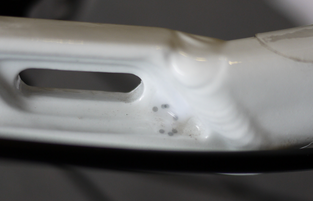We’ve been asked to review a security product from Datatag for bikes, which combines marking your bike for identification with database registration in the event of its recovery after theft. It’s called the UV Stealth Pro.
What is the Datatag UV Stealth Pro system?
Datatag specialise in security ID systems. As part of their range of products, they also produce a security identification system for bicycles, called the ‘UV stealth’ system.
While there are several versions of the kit, the one we were sent to review here at Pedelecs is the UV ‘Stealth’ PRO system. This allows you to UV etch your bike, apply a visible deterrent sticker and use ‘microdots’ to mark individual components.
While the idea behind the visible sticker is to act as a deterrent to opportunistic thieves, the permanently marked ID code on the bike is also registered with the Datatag database system, which the police have access to when recovering stolen bikes. The authorities have also been issued with ‘thousands’ of scanners and in the unhappy event of having your bike stolen, Datatag will add a flag to your database entry.
Some e-bikes, such as KTM, are now sold already marked and registered with Datatag straight from the showroom. But for those who want to know more about buying the product separately, we’ve reviewed what’s in the pack, how much it costs and how it works.
Unfortunately bikes, both ordinary cycles and e-bikes, are an attractive target for thieves. Despite their high value, they’re sometimes left poorly secured and are easy to dispose of through numerous channels, including being broken up into component parts that are valuable in their own right.
In 2010/11 over 100,000 cycle thefts were reported to the police. However, because of high levels of under-reporting it is estimated that only one cycle theft is reported for every five stolen – resulting in approximately ½ million cycles stolen in one year alone. Some slightly more positive news emerged from the British Crime Survey in 2013, which stated that cycle theft statistics were down 22% compared to 2012.
However, reuniting stolen bikes with their rightful owners poses a significant further problem. In October last year, Transport for London reported over 2,000 bikes were lying unclaimed in the capital’s police stations, with no means of identifying who they belonged to.
For e-bikes that are recovered by the police therefore, identification and marking on the bike means you are able to easily prove ownership and stand a greater chance of its return back to you.
Finally, Datatag registration of the bike is transferable should you sell it.
What’s in the pack?
- Installation Guide
- Stealth UV etching kit:- 4 UV etches to permanently mark your frame, forks and wheels. The etches do not visibly mark the paintwork (some exceptions, please see their website).
- Ultimate TE Label:- A highly visible, tamper-resistant sticker with unique ID and QR (machine readable) code – the sticker can’t be removed without damaging it.
- Datadots:- A microdot identification system that can be applied to any surface, thus making it very difficult for the criminals to locate and remove them all. They can be used to mark components and accessories.
- Registration form – telling you to visit the Datatag website and register your / bike details on their database.
- The pack also includes an alcohol wipe.
So how does it work?
The whole process from start to finish took about 30 minutes including the time to fully read the instructions:
“Stealth” UV etching
Firstly, I applied the UV marking. These are UV ‘etches’ that permanently mark your frame, forks and wheels with the unique ID number. This part of the kit consists of 4 ‘stickers’ which need to be stuck to your bike. This could be your crossbar, downtube, seat tube, forks etc.
Rub the target area with the alcohol wipe, then dry (I used a piece of kitchen towel). Apply the sticker, being careful to push out any air bubbles to the side. You don’t need to stick the whole sticker down, just enough to cover the lettering.
Then take the UV marking solution. Remove the lid and dip the applicator in the bottle. Then in a smooth motion, wipe across the lettering, taking care not to let any drips fall onto any other part of your paintwork/bike. If you do, wipe it off quickly. Only 1 coat is needed.
Then wait 30 seconds and carefully peel back the label. You should see a white powdery residue which you then need to wipe off using the supplied alcohol wipe. To check it has worked, shine a UV torch on it.
Here is what the end result looks like :
Datadots
Datadots are tiny microdots containing your kit’s unique identification code. You apply these to discreet/inconspicuous areas of your e-bike as well as individual components and accessories, such as underneath brake levers, gearing, frame drop outs etc.
The little bottle is said to contain at least 1,000 microdots in a UV laquer solution.
My first application was a bit hit and miss, but a good shake of the bottle and I picked up a few dots.
When the solution dries they look like small pieces of dirt or blemishes.
Ultimate TE Label
The final step is to apply the visual deterrent and you put this is a prominent position. I put mine on the top bar. The sticker has the words ‘datatag’, a unique ID number and a scannable QR code.
What does it cost?
RRP £29.99
Summary
In a way, the Datatag system is a difficult product to review. It’s the kind of product you hope you never need to use and it goes without saying that ensuring your e-bike isn’t left vulnerable to theft in the first place is priority. But at the same time, if something does go wrong you want to improve the odds of getting your bike back.
The kit is a great idea in terms of giving you the best chance possible to see your bike again and it’s easy to apply.
If there was one doubt in my own mind, it was that I wasn’t sure whether to use the visible sticker or just apply the covert, ‘stealth’ ones. My thought train was “why alert the thief that there is something they need to look for and attempt to remove?”
On the flipside, I can see that for a thief who sees that sticker and knows what it is, it may push them on to an easier steal further down the road.
The chances are though, you’ve made a significant investment in your electric bike and are probably now quite attached to it too. Cycle theft has also, understandably, put some off buying a replacement, which is a shame when there’s so many benefits to be had from an e-bike and cycling in general.
Given the crime statistics then, to me it does make sense to protect your cherished e-bike as far as is possible and at a penny under £30 and 30 minutes of your time for a little extra peace of mind, in my view it’s very worthwhile.
Pedelecs forum members are vigilant for ‘dodgy looking’ e-bikes turning up on Ebay (without a battery and charger for instance). This area of the forum helps people to reunite stolen electric bikes with their owners.
Further security can be purchased in the form of electric bike insurance too – BEBA now offer e-bike insurance with 10% off for those that have DataTag fitted to their e-bike. At the time of writing the average premium from Velosure is between £100 and £120 annually (rated on the bike value).
Thanks to Datatag/Fli Distrubution for sending this product for review.
You can view the full set of photos related to this review here – Datatag Bicycle Security Kit


